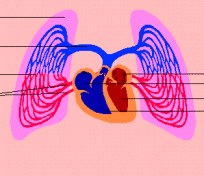|
Clinical Goals of Incentive Spirometry |
|
The clinical goals of appropriately applied and supervised sustained maximal inspiration in incentive spirometry therapy include:
|

|
- Optimize cough mechanism. Optimizing the patient's inspiratory capacity helps provide an optimal forced vital capacity (FVC) for coughing.
- Early detection of acute pulmonary disease. By frequently applying SMI efforts, the RCP can establish a base line for an individual patient. A sudden decrease in the patient's ability to perform the maneuver signals the need for careful pulmonary evaluation for acute disease. Experience has shown that sudden changes in SMI results preceeds obvious evidence of pneumonia or atelectasis by anywhere from 12 to 24 hours. Hence incentive spirometry can act as an early warning system for the practitioner.
Indications for Incentive Spirometry
The clinical indications for incentive spirometry are:
- Presence of pulmonary atelectasis
- Presence of conditions predisposing to atelectasis:
Upper abdominal surgery
Thoracic surgery
Surgery in patients with COPD
- Presence of a restrictive lung defect associated with quadraplegia and/or dysfunctional diaphragm
The primary indication for IS is to treat existing atelectasis. IS may also be used as a preventive measure when conditions exist that make the development of atelectasis likely. Clinical conditions predisposing to atelectasis include upper abdominal and thoracic surgery, and any major surgery on COPD patients that requires general anesthesia. Last, patients with neuromuscular disorders which restrict use of the diaphragm may benefit from IS.
Criteria for SMI Therapy
The guidelines for appropriate administration of incentive spirometry (SMI) for the acutely ill patient are:
- the patient must be motivated and cooperative
- the patient's lungs should be without acute atelectasis, pneumonia, or retained secretions
- an FVC greater than 15 ml/kg or inspiratory capacity greater than 12 ml/kg should be obtainable
- patient should have a respiratory rate of less than 25 per minute
Given these conditions, the patient is potentially capable of an effective SMI, and the RCP then has responsibility for providing instructions for performing SMI therapy.
The goals of incentive spirometry are to prevent or reduce atelectasis in the postsurgical patient. The patient is instructed to take four to five deep breaths using the device every hour. The procedure to be followed is as follows:
- Verify the physician's order in the patient's chart.
- Identify the patient by wrist band and verbally.
- Identify yourself to the patient and explain the procedure and why
it has been ordered by the physician. Technical aspects of the device
should be thoroughly explained.
- Place the patient in a position as near to upright as possible. If
the patient cannot be moved, incentive spirometry can still be performed
if the patient is coached carefully.
- With the unit in an upright position, have the patient exhale normally,
then inhale through the device rapidly and deeply until the goal is
achieved. Proper breathing technique and positioning must be taught
in conjunction with the use of the device.
- The patient should continue to inhale as long as possible to achieve
full inspiratory capacity. The initial inspiratory goal should be twice
the patient's measured VT, but this may have to be increased or decreased
to find an appropriate initial goal. If the patient is unable to manifest
twice the measured VT after orientation of the technique, the appropriateness
of SMI therapy should be reevaluated.
- Each procedure should be geared to four or five successful attempts
at preset goals.
- The patient should be instructed to use the therapy every waking hour;
one SMI maneuver each 30 to 60 seconds (by the clock), repeated four
to five times. This routine will avoid hypocarbia secondary to hyperventilation,
avoid exhausting the patient, and limit the therapy to 5 minutes of
each hour.
- The patient's goals and performance should be evaluated at least twice
daily.
- Record all pertinent data on the patient's chart. This should include date, time, flow or volume achieved, practitioner's evaluation of therapy and anything else that is relevant.